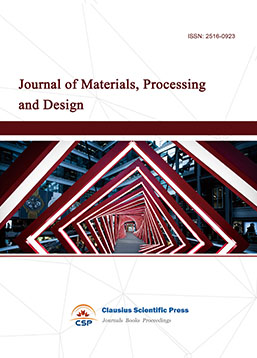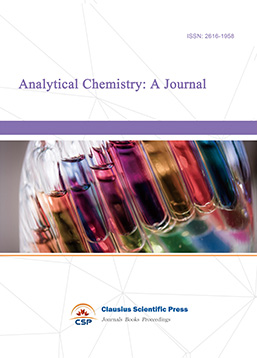DESORPTION STUDIES OF Pb, Cd, AND Fe (III) IONS FROM UNMODIFIED RAPHIA PALM FRUIT (RAPHIA HOOKERI)
DOI: 10.23977/jbiomm.2022.010101 | Downloads: 20 | Views: 3694
Author(s)
Abasi C. Y. 1, Orodu V. E. 1, Benson O. 1
Affiliation(s)
1 Department of chemical Sciences, Niger Delta University, Wilberforce Island, Bayelsa State, Nigeria
Corresponding Author
Abasi C. Y.ABSTRACT
Batch desorption experiments were carried out on four raphia palm (Raphia hookeri) fruit biomasses sorbed with Pb, Cd, and Fe(III) ions, using HCl and NaOH as desorbing solutions. Results showed that for both acid and alkaline desorption, Pb2+ proved to be the most desorbed among the three metal ions considered. Maximum percent desorption was 98.35% on the UEN biomass. On a general consideration, MEP biomass appeared to be the best by which the metal ions could be desorbed. The modified biomasses were more generally desorbed than the unmodified. There was a general pattern of dependence for all the metal ions considered, such that desorption decreased with increase in concentration loaded on the biomasses.
KEYWORDS
Desorption, adsorption, biomass, unmodified, modified, unmodified, metalsCITE THIS PAPER
Abasi C. Y., Orodu V. E. and Benson O., DESORPTION STUDIES OF Pb, Cd, AND Fe (III) IONS FROM UNMODIFIED RAPHIA PALM FRUIT (RAPHIA HOOKERI). Journal of Biomaterials and Biomechanics (2022) Vol. 1: 1-12. DOI: http://dx.doi.org/10.23977/jbiomm.2022.010101.
REFERENCES
[1] B. Volesky, Biosorbent materials, Biotechnology and bioengineering symposium, 1986, pp. 121-126.
[2] N. Das, R. Vimala, P. Karthika, Biosorption of heavy metals–An overview Indian Journal of Biotechnology, 7 (2008) 159 – 169.
[3] C. Stöhr, C. Bartosch, R. Kiefer, W.H. Höll, Separation of mixtures of heavy metals by parametric pumping with variation of pH, Chemical engineering & technology, 24 (2001) 879-883.
[4] M.J. Horsfall, A. Arbia, A. Spiff, Removal of Cu (II) and Zn (II) ions from wastewater by cassava (Manihot esculenta Cranz) waste biomass, African Journal of Biotechnology, 2 (2003) 360-364.
[5] Z.A. Alothman, A.H. Bahkali, M.A. Khiyami, S.M. Alfadul, S.M. Wabaidur, M. Alam, B.Z. Alfarhan, Low cost biosorbents from fungi for heavy metals removal from wastewater, Separation Science and Technology, 55 (2020) 1766-1775.
[6] B.A. Ezeonuegbu, D.A. Machido, C.M.Z. Whong, W.S. Japhet, A. Alexiou, S.T. Elazab, N. Qusty, C.A. Yaro, G.E. Batiha, Agricultural waste of sugarcane bagasse as efficient adsorbent for lead and nickel removal from untreated wastewater: Biosorption, equilibrium isotherms, kinetics and desorption studies, Biotechnology reports (Amsterdam, Netherlands), 30 (2021) e00614.
[7] H. Seki, A. Suzuki, S.-I. Mitsueda, Biosorption of heavy metal ions onRhodobacter sphaeroidesandAlcaligenes eutrophusH16, Journal of Colloid and Interface Science, 197 (1998) 185-190.
[8] S.P. Mishra, Adsorption–desorption of heavy metal ions, Current Science, 107 (2014) 601-612.
[9] S. Lata, Regeneration of adsorbents and recovery of heavy metals: a review, International journal of environmental science and technology, v. 12 (2015) pp. 1461-1478-2015 v.1412 no.1464.
[10] A. Chatterjee, J. Abraham, Desorption of heavy metals from metal loaded sorbents and e-wastes: A review, Biotechnology letters, 41 (2019) 319-333.
[11] A. Sari, M. Tuzen, Kinetic and equilibrium studies of biosorption of Pb(II) and Cd(II) from aqueous solution by macrofungus (Amanita rubescens) biomass, J Hazard Mater, 164 (2009) 1004-1011.
[12] M. Horsfall Jnr, F.E. Ogban, E.E. Akporhonor, Recovery of lead and cadmium ions from metal-loaded biomass of wild cocoyam (Caladium bicolor) using acidic, basic and neutral eluent solutions, Electronic Journal of Biotechnology, 9 (2006) 152 - 156
[13] T.H. Baig, A.E. Garcia, K.J. Tiemann, J.L. Gardea-Torresdey, ADSORPTION OF HEAVY METAL IONS BY THE BIOMASS OF SOLANUM ELAEAGNIFOLIUM (SILVERLEAF NIGHTSHADE) Proceedings of the Conference on Hazardous Waste Research, 1999, pp. 131-142.
[14] M.H. Jnr, A.I. Spiff, Equilibrium sorption study of Al3+, Co2+ and Ag+ in aqueous solutions by fluted pumpkin (Telfairia occidentalis HOOK f) waste biomass, Acta Chim. Slov, 52 (2005) 174-181.
[15] F. Okieimen, A. Maya, C. Oriakhi, Sorption of cadmium, lead and zinc ions on sulphur-containing chemically modified cellulosic materials, International journal of environmental analytical chemistry, 32 (1988) 23-27.
[16] G. Mckay, M. El Geundi, M. Nassar, Equilibrium studies during the removal of dyestuffs from aqueous solutions using bagasse pith, Water research, 21 (1987) 1513-1520.
[17] Y. Ho, Wase, DAJ, C. CF Forster, Removal of lead ions from aqueous solution using sphagnum moss peat as adsorbent, Water SA, 22 (1996) 219-224.
[18] D.R. Crist, R.H. Crist, J.R. Martin, J.R. Watson, Ion exchange systems in proton—metal reactions with algal cell walls, FEMS Microbiology Reviews, 14 (1994) 309-313.
[19] J.L. Gardea-Torresdey, G.d.l. Rosa, J.R. Peralta-Videa, Use of phytofiltration technologies in the removal of heavy metals: A review, Pure and Applied Chemistry, 76 (2004) 801-813.
[20] J.L. Gardea-Torresdey, K.J. Tiemann, J.H. Gonzalez, I. Cano-Aguilera, J.A. Henning, M.S. Townsend, Removal of nickel ions from aqueous solution by biomass and silica-immobilized biomass of Medicago sativa (alfalfa), Journal of Hazardous Materials, 49 (1996) 205-216.
[21] J.L. Gardea-Torresdey, K.J. Tiemann, G. Gamez, K. Dokken, Effects of chemical competition for multi-metal binding by Medicago sativa (alfalfa), J Hazard Mater, 69 (1999) 41-51.
[22] M.A. Hashim, H.N. Tan, K.H. Chu, Immobilized marine algal biomass for multiple cycles of copper adsorption and desorption, Separation and Purification Technology, 19 (2000) 39-42.
[23] M. Iqbal, A. Saeed, N. Akhtar, Petiolar felt-sheath of palm: a new biosorbent for the removal of heavy metals from contaminated water, Bioresource Technology, 81 (2002) 151-153.
[24] N. Akhtar, A. Saeed, M. Iqbal, Chlorella sorokiniana immobilized on the biomatrix of vegetable sponge of Luffa cylindrica: a new system to remove cadmium from contaminated aqueous medium, Bioresource Technology, 88 (2003) 163-165.
[25] S.K. Lister, M.A. Line, Potential utilisation of sewage sludge and paper mill waste for biosorption of metals from polluted waterways, Bioresource Technology, 79 (2001) 35-39.
[26] R.S. Bai, T.E. Abraham, Studies on chromium(VI) adsorption-desorption using immobilized fungal biomass, Bioresour Technol, 87 (2003) 17-26.
| Downloads: | 20 |
|---|---|
| Visits: | 3694 |
Sponsors, Associates, and Links
-
Forging and Forming

-
Composites and Nano Engineering

-
Journal of Materials, Processing and Design

-
Metallic foams

-
Smart Structures, Materials and Systems

-
Chemistry and Physics of Polymers

-
Analytical Chemistry: A Journal

-
Modern Physical Chemistry Research

-
Inorganic Chemistry: A Journal

-
Organic Chemistry: A Journal

-
Progress in Materials Chemistry and Physics

-
Transactions on Industrial Catalysis

-
Fuels and Combustion

-
Casting, Welding and Solidification

-
Journal of Membrane Technology

-
Journal of Heat Treatment and Surface Engineering

-
Trends in Biochemical Engineering

-
Ceramic and Glass Technology

-
Transactions on Metals and Alloys

-
High Performance Structures and Materials

-
Rheology Letters

-
Plasticity Frontiers

-
Corrosion and Wear of Materials

-
Fluids, Heat and Mass Transfer

-
International Journal of Geochemistry

-
Diamond and Carbon Materials

-
Advances in Magnetism and Magnetic Materials

-
Advances in Fuel Cell


 Download as PDF
Download as PDF